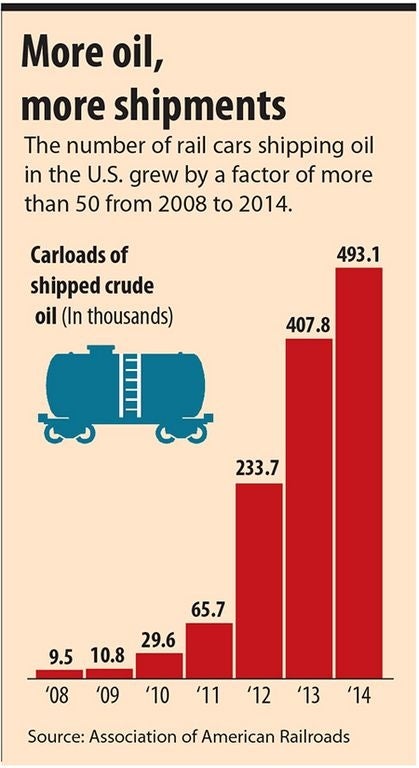Tons of freight roll daily into and out of Worcester on tracks used by CSX, Pan Am Railways and the Providence & Worcester railroads. As the economy continues to bounce back from the Great Recession, freight transportation is growing as well, bringing more goods of all kinds through the region on the rails — everything from cars and toilet paper to flammable liquids and hazardous materials.
By law, these railroads must offer reasonable terms on shipping of hazardous materials, especially flammable goods such as oil and ethanol.
The amount of flammable material shipped through any area is difficult to enumerate. While railroad and safety officials have access to databases detailing shipments, the information is private due to security and other concerns. Shipments of flammable liquids have grown, as have all other railroad shipments, according to Ed Greenberg, a spokesman for the Association of American Railroads. The shipments of oil, while still a small part of all rail shipments, have grown as U.S. and Canadian oil production has increased.
Worcester official: Public is safe
Disasters involving trains that carry flammable liquids, such as the deaths of 47 people in a derailment in Quebec in 2013 and another in West Virginia that set 3 million gallons of oil on fire, have drawn attention to these shipments and the regulations surrounding them.
But people who live and work in Worcester should not be concerned about these flammable materials being shipped through the area, Deputy Fire Chief John Sullivan said.
The Fire Department has access to databases and is aware of the types of shipments moving through the area, he said. Most of the railroads that run through the city don’t transport much flammable material, he said. Providence & Worcester (P&W) shipments tend to be ethanol while CSX deals mostly in propane and other petrochemicals, Sullivan said.
The fire department takes necessary precautionary steps, he said, but goods need to move through the area.
New regulations
In May, the U.S. Department of Transportation released new rules to improve the safety of the ongoing transportation of flammable materials. The rules include speed restrictions — 40 mph in urban areas, 50 mph elsewhere — for high-hazard trains that include a continuous block of 20 or more tank cars loaded with a flammable liquid, or 35 or more of those tank cars dispersed throughout a train.
There are also guidelines on a new tanker design and retrofitting requirements on older tankers scheduled to be implemented by 2023. The new regulations regarding the tanker cars will mostly affect producers, shipping companies and those that rent train cars, Pan Am spokeswoman Cynthia Scarano said, explaining that most railroads actually own only a small percentage, if any, of the cars they transport.
P&W’s secretary and general counsel, Charles D. Rennick, declined to comment on flammable shipments in the area, but said the company will abide by any new regulations and doesn’t expect they will impact freight service.
Pan Am transports 8.4 million net tons of traffic through Massachusetts every year on 2,000 miles of track. The railroad already abides by a 30-mph limit while moving hazardous or flammable materials through urban areas, Scarano said. Reduced speed is not an issue for the relatively local railroad, but it could cause traffic problems along longer lines that traverse the country, Scarano said.
For CSX, a national carrier, hazardous and flammable materials are reported as part of its chemicals portfolio and represent about 9 percent (in volume) of the freight its moves, CSX spokesman Rob Doolittle said.
The company has already reduced the speed limit for trains carrying 20 or more tankers of crude oil, ethanol and other flammable commodities in federally designated “high threat urban areas” to 40 mph, consistent with federal requirements, according to Doolittle.
“The operational impact of these new rules is limited, especially in areas like Massachusetts where flammable materials comprise a small portion of the freight that we carry,” he said.

